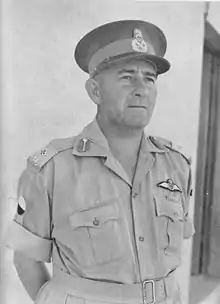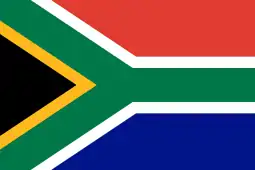Hendrik Klopper
General Hendrik Balzazar Klopper (also Balthazar), DSO[1] was a South African military commander. He commanded the 3rd Infantry Brigade and was later promoted to command the 2nd Infantry Division during the Western Desert Campaign of the Second World War. He is best known for surrendering the Division to Rommel after the failed defence of the Tobruk harbour in June 1942. After the war, he became Army Chief of Staff from 1950 to 1953, and Commandant General of the Union Defence Force from 1956 until his retirement in 1958.
Hendrik Balzazar Klopper | |
|---|---|
 Major General Hendrik Klopper in June 1942 | |
| Born | 25 September 1903 |
| Died | 30 December 1977 (aged 74) |
| Allegiance | South Africa |
| Service/ | South African Army |
| Years of service | 1924–1958 |
| Rank | General |
| Commands held | Commandant General of the Union Defence Force (1956–58) Army Chief of Staff (1950–53) Northern Command (1945–50) South African Army College (1944–45) 2nd Infantry Division (1942) 3rd Infantry Brigade (1942) 1 Special Service Battalion (1938–39) |
| Battles/wars | Second World War |
| Awards | Distinguished Service Order |
Military career
Klopper joined the South African Army in 1924.
World War II
During the Second World War, he commanded the 3rd Infantry Brigade in the North African Campaign,[2] for which he was awarded the Distinguished Service Order.[3] He then briefly commanded 2nd Infantry Division. As fortress commander, Klopper was forced to surrender Tobruk and its garrison to Axis forces on 21 June 1942. He escaped from captivity in 1943 and was exonerated by a 1942 Court of Inquiry into the Tobruk disaster.[4]:138
South African Army College
Klopper was Officer Commanding the South African Army College from 1944 to 1945, before being appointed in command of Northern Command in 1945.[5]
Post-war
Klopper served as Army Chief of Staff from 1951 to 1953, as Inspector-General from 1953 to 1956, and as Commandant General of the Union Defence Force from 1956 to 1958.
References
- "KLOPPER H.B. 1903–1977". eGGSA Library. The Genealogical Society of South Africa:eGGSA Branch. 24 February 2003. Retrieved 3 October 2014.
- "The Generals of WWII: Klopper, Hendrik Balzazer". generals.dk. Retrieved 3 October 2014.
- "The London Gazette, Issue 35697, page 3948". The Gazette. The London Gazette. 8 September 1942. Retrieved 3 October 2014.
- Hartshorn, Eric P. (1960). Avenge Tobruk. Cape Town: Purnell & Sons. OCLC 26084683.
The fact that Tobruk fell must undoubtedly be attributed to the eleventh-hour reversal of policy leading to the decision to hold the Fortress, regardless of the fact that Eighth Army was then in full retreat in the face of an enemy who had been uniformly successful and whose morale must in consequence have been high. It was impossible in the time available to make adequate preparations for the completely new role imposed upon the Garrison...
Hartshorn's book reveals in detail the Court of Inquiry's terms of reference and relevant findings. - Uys, Ian (1992). South African Military Who's Who 1452–1992. Fortress Publishers. ISBN 0-9583173-3-X.
| Military offices | ||
|---|---|---|
| Preceded by Christiaan du Toit |
Commandant General of the Union Defence Force 1956–1958 |
Succeeded by Stephen Melville |
| New title Retitled from Director-General of Land Forces |
Army Chief of Staff 1951–1953 |
Succeeded by Pieter Grobbelaar |
| Preceded by Christiaan du Toit |
Director-General of Land Forces 1950–1951 |
Retitled Army Chief of Staff |
| Preceded by Jock Kriegler |
Officer Commanding South African Army College 1944–1945 |
Succeeded by SJ Joubert |
| Preceded by JR Wocke |
Commanding Officer 1 Special Service Battalion 1938–1939 |
Succeeded by Pik van Noorden |
